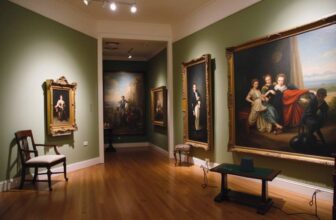
Fine Art vs. Real Estate: The Battle of the Luxury Investments
When it comes to luxury investments, two asset classes consistently dominate the portfolios of the world’s wealthiest individuals , fine art and real estate. Each represents more than just financial growth; they embody status, taste, and legacy. But as global markets evolve, investors are asking: which luxury investment truly delivers superior long-term value , fine art or real estate?
Both have proven to be reliable stores of wealth, especially in times of inflation and market volatility. However, the nuances of ownership, liquidity, and cultural prestige make them uniquely different. Understanding how each functions as an asset , and as a symbol of affluence , can shape how modern investors diversify their luxury portfolios.
Fine Art as an Investment: The Allure of Cultural Capital
Fine art has long been the currency of the elite. From Renaissance masterpieces to contemporary digital art (NFTs included), owning art isn’t just about possessing beauty , it’s about owning cultural capital.
1. Performance and Returns in the Art Market
Over the last few decades, the global art market has expanded beyond galleries and auctions. According to UBS and Art Basel’s 2024 Art Market Report, the global art market surpassed $68 billion, with consistent growth even during economic uncertainty. High-quality works by established artists like Picasso, Basquiat, and Monet have delivered annualized returns of 7–10% over the long term.
While not as liquid as stocks, fine art often outperforms traditional markets during inflationary periods, making it a hedge against economic instability. Ultra-wealthy collectors view art as both a store of value and a cultural hedge, appreciating its emotional and aesthetic returns alongside financial gain.
2. Barriers to Entry and Accessibility
Investing in fine art has historically been reserved for insiders , those with access to elite auction houses and private dealers. However, fractional art investment platforms like Masterworks and Yieldstreet have begun democratizing this space, allowing investors to buy shares in multimillion-dollar artworks.
Still, the true luxury appeal lies in direct ownership. Owning a Warhol or Rothko is more than a portfolio move; it’s a declaration of taste and prestige. For high-net-worth individuals, fine art remains one of the most exclusive and socially validated investments on earth.
3. Risks and Volatility in Fine Art
Despite its allure, art carries significant risks. Valuation is subjective , driven by trends, reputation, and provenance. Liquidity is limited; selling a masterpiece can take months or years. Moreover, storage, insurance, and maintenance costs can add up to 2–3% annually of the artwork’s value.
Art is also vulnerable to fakes and forgeries, as well as shifts in collector sentiment. While blue-chip art tends to hold value, emerging artists can fluctuate wildly. This makes fine art ideal for investors with long-term horizons and passion-driven portfolios.
Real Estate as an Investment: Tangibility and Timeless Wealth
If fine art is emotional, real estate is tangible. Luxury properties , from penthouses in Manhattan to villas in the South of France , have historically been the cornerstone of wealth preservation for the ultra-rich. In fact, Knight Frank’s 2024 Wealth Report revealed that over 80% of high-net-worth individuals own multiple properties across global markets.
1. Performance and Stability in Real Estate
Luxury real estate consistently delivers annualized returns between 8–12% in prime markets, factoring in rental yields and appreciation. Unlike art, which may sit in a private collection, luxury properties can generate passive income while appreciating over time.
Prime real estate also offers inflation protection. Land and property values tend to rise with the cost of living, making real estate one of the most stable physical assets during economic downturns. Cities like London, Dubai, Singapore, and New York remain safe havens for global capital , with high liquidity and constant demand from international buyers.
2. Barriers to Entry and Market Dynamics
While fine art can be purchased in smaller increments, real estate requires substantial upfront capital and ongoing expenses such as taxes, maintenance, and management fees. However, the introduction of real estate investment trusts (REITs) and fractional ownership models has made luxury real estate more accessible to institutional and retail investors.
Real estate also offers financing flexibility. Investors can leverage properties, using mortgages or collateral to expand their portfolios , something nearly impossible with art. This ability to borrow against tangible assets increases real estate’s strategic appeal for wealth growth and liquidity management.
3. Risks and Market Volatility in Real Estate
Real estate, while relatively stable, is not immune to risk. Market cycles, interest rates, and geopolitical shifts can cause sharp fluctuations in property values. Additionally, maintenance costs, tenant issues, and regulatory changes can erode profits.
However, unlike art, real estate produces measurable utility , it can be rented, developed, or redeveloped. Its intrinsic usefulness gives it a foundation of value that does not depend solely on taste or market perception.
Fine Art vs. Real Estate: Comparing Key Investment Metrics
| Investment Factor | Fine Art | Real Estate |
|---|---|---|
| Liquidity | Low | Moderate to High |
| Volatility | Medium to High | Medium |
| Average Annual Return | 7–10% (blue-chip works) | 8–12% (prime markets) |
| Holding Costs | 2–3% (insurance, storage) | 1–2% (maintenance, taxes) |
| Inflation Hedge | Strong | Very Strong |
| Utility Value | Aesthetic, cultural | Tangible, functional |
| Access Level | Exclusive | Broad, with leverage options |
| Emotional Appeal | High | Moderate |
| Liquidity Timeline | Months to years | Weeks to months |
| Status Symbol Value | Extremely High | High |
This comparison underscores that both fine art and real estate serve different roles in a luxury investment portfolio. Fine art offers cultural and symbolic value unmatched by any other asset class, while real estate delivers tangible security and steady income potential.
Fine Art vs. Real Estate as Symbols of Wealth
1. Fine Art: The Invisible Badge of Cultural Prestige
Fine art represents a discreet yet powerful symbol of wealth. Unlike cars or jewelry, art isn’t always flaunted , it’s displayed in private galleries, penthouses, or museums. The social capital derived from collecting art lies in cultural literacy and access to elite networks.
Owning an original Rothko or Kusama signals more than financial success , it signals intellectual sophistication and belonging to a global cultural elite. Art collecting has become a form of social currency, granting access to exclusive events, foundations, and collaborations with major museums.
2. Real Estate: The Visible Marker of Affluence
Real estate, on the other hand, is a public declaration of prosperity. Iconic addresses , such as Park Avenue, Knightsbridge, or Beverly Hills , instantly communicate financial power and permanence. High-net-worth investors often acquire signature properties to showcase their global footprint and lifestyle diversity.
Beyond prestige, luxury real estate represents security and legacy. It is an intergenerational asset that can be passed down, redeveloped, or transformed into income-producing estates. For many family offices, prime property remains the foundation of dynastic wealth.
Diversification Strategy: Why Savvy Investors Own Both
For elite investors, the debate isn’t necessarily fine art vs. real estate, but rather how to balance both. A well-structured luxury portfolio leverages the unique strengths of each:
Fine Art offers portability, privacy, and emotional resonance.
Real Estate provides cash flow, leverage, and enduring utility.
By combining the two, investors can create a diversified hedge against both market volatility and inflation. Real estate delivers stability and income, while fine art offers cultural and speculative upside. Together, they serve as a comprehensive wealth preservation strategy that transcends traditional asset classes.
Portfolio Allocation Example
Wealth advisors typically recommend allocating 5–10% of net worth to fine art and 20–30% to real estate, depending on liquidity needs and risk appetite. Art’s illiquidity makes it a long-term store of value, while real estate can serve as a more active, income-generating asset.
Global Trends in Luxury Investments (2025 and Beyond)
1. The Rise of Digital Art and Tokenization
Blockchain technology has revolutionized how art is bought, sold, and authenticated. NFTs (non-fungible tokens) have introduced a new asset class for collectors seeking liquidity and traceable provenance. Tokenized ownership also allows for fractional investing, blurring the line between traditional art and digital assets.
This shift could make fine art more liquid and accessible, enhancing its appeal to tech-savvy investors.
2. The Surge of Experiential Real Estate
In contrast, the real estate market is witnessing growth in experiential and branded developments , think Aman Residences, Ritz-Carlton-branded villas, and ultra-private eco-estates. These properties offer experiences and lifestyle value, not just square footage.
Luxury buyers now prioritize privacy, wellness, and exclusivity, driving strong demand in secondary markets such as Portugal’s Algarve, Costa Rica, and the Greek islands.
3. Globalization of Wealth and Asset Mobility
With geopolitical instability and shifting tax policies, wealth mobility is a defining trend. Art, being portable and discreet, allows investors to move capital across borders efficiently. Real estate, though less mobile, remains crucial for citizenship and residency programs, offering financial and geopolitical security.
Fine Art vs. Real Estate: The Psychological Dimension
Art Speaks to the Soul
Art appeals to emotion, intellect, and legacy. It is deeply personal , an expression of identity and worldview. For many collectors, the satisfaction of living with beauty and history outweighs any financial gain. This emotional dividend cannot be quantified but adds immense personal value.
Real Estate Speaks to Stability
Real estate, meanwhile, appeals to the primal human desire for security and belonging. It’s not just an investment , it’s a footprint. For the ultra-wealthy, property embodies permanence in a transient world. It’s both a status symbol and a sanctuary, providing comfort amid economic uncertainty.
The Verdict: Which Luxury Investment Wins?
Declaring a single winner between fine art and real estate is impossible , their strengths complement each other in a sophisticated portfolio.
For investors seeking steady income, leverage, and tangible security, real estate remains unmatched.
For those driven by passion, legacy, and cultural capital, fine art offers intangible yet powerful returns.
The world’s most successful collectors and investors , from François Pinault to Larry Ellison , understand this balance. They diversify across tangible and cultural assets, using each to amplify the other.
Ultimately, the true luxury isn’t choosing between fine art and real estate , it’s the freedom to own both, to shape wealth that is both visible and visionary.




